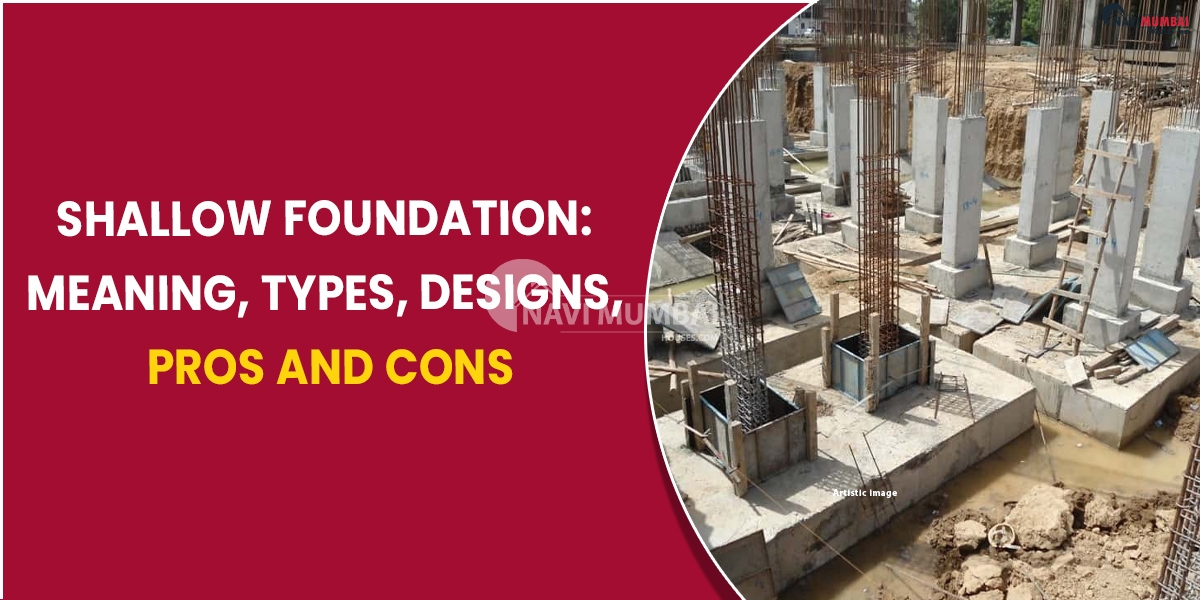
- March 3, 2023
- Uncategorized
Shallow foundation: Meaning, types, designs, pros and cons
Are You Looking for 3Bhk flat in Kharghar ?
What is a shallow foundation?
Why is shallow foundation used?
The use of shallow foundations allows for the distribution of structural loads over a large, horizontal area at a shallow depth below earth.
shallow foundation types
Shallow foundations come in many different forms, and they are all categorised based on the foundation’s size, shape, and general construction.
Strip footings for a shallow base
The use of a strip footing is one method for supporting a load-bearing wall. The footings cross each other due to the layout.
Shallow foundation: Isolated footings
shallow foundation: cantilever footings
A single set of combined or cantilever footings supports multiple columns.
Raft foundations: shallow foundations
A raft foundation, which is a kind of slab foundation, may sustain numerous columns and walls.
Shallow foundation: Design criteria
- It is essential to study as much as you can about the history of the site and the strata below the earth in order to accurately assess the placement of a foundation, including its position and depth.
The foundation should be erect in a place that is immune to all potential future effects in order to guarantee excellent performance. The footing must be proportion properly to prevent the ground from disastrously falling on top of the foundation in order to give safety against carrying capacity. If the applied load is greater than the soil’s shear strength, that is the situation. Thus, it is essential to have a thorough understanding of the geotechnical characteristics of the relevant rocks and soils.For a building to preserve its structural integrity, the settling must be kept to a reasonable level. The aggradation of the surrounding ground and soil deformation brought on by applied shear stresses are the causes of the significant settling.Again, determining how long it will take for the structure to settle once construction is finish requires a thorough grasp of the geotechnical characteristics of the soil.
Shallow foundation design: Steps to follow
- Determine how much weight the footing is bearing.
- Get a soil sample or profiles showing the location’s different soil divisions.
- Identify the highest point the water can get to.
- Get the pertinent field measurements and results from the lab testing.
The footing’s size and location should be determine. - Determine the maximum weight that the supporting stratum can support.
The footing sizes should be adjust as appropriate. - Pay close attention to the footing’s contact pressure.
- Check to see if the footing is secure when subjected to sliding, lifting, and overturning pressures.
- Estimate both the overall amount and the gap between the settlements.
- Create the footing’s framework.
Ascertain whether moisture proofing, insulation, or foundation drains are require.
Shallow foundation benefits
The labour expenses relate to excavation activities may be lower since less excavation is need. - The lower depth required for foundation installation facilitates the creation of shallow foundations.
- The equipment and tools required to construct a shallow foundation are simple to use and reasonably priced.
- It is feasible to build shallow foundations quickly, which not only helps save money but also lowers the cost of hiring staff and equipment.
- Since it causes less ground disturbance, building on top of shallow foundations is better for the ecology and environment.
The likelihood of settling is reduce if the ground is compressible. - The use of expensive pilings is unnecessary.
- As a result, it is simpler to predict how shallow foundations and the soil beneath them would behave.
With deep foundations, there is a higher depth of soil involve, hence the level of uncertainty rises as well.
Disadvantages of a shallow foundation
A building’s chances of being scoure increase if it is close to a river or the ocean. In certain situations, a shallow foundation cannot be use. - When the subsoil water level is high, it is impossible to use a shallow foundation and it would be expensive to pump the water out of the pit or canal.
It cannot be use in areas where the top surface soil’s bearing capacity is lower. It cannot be use in circumstances when the framework is heavy and the load is distribute unevenly on the structure.
Shallow foundation: Ideal depth for maximum durability
2 bhk flat for sale in navi mumbai
You’re looking for Buy Home In Kalyan we have the Best Buy Properties In Mumbai Like Ready to Move & Nearby possession:
https://navimumbaihouses.com/property/search/buy/titwala/
If you want daily property update details please follow us on Facebook Page / YouTube Channel / Twitter









